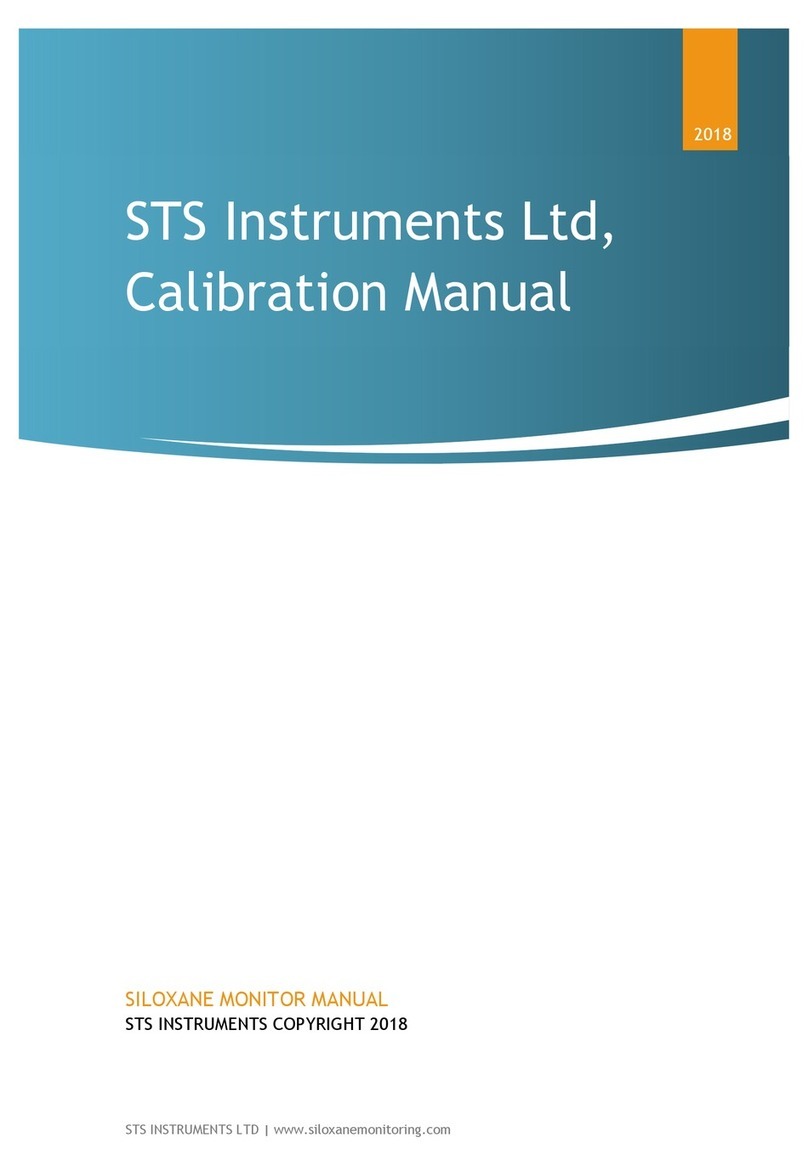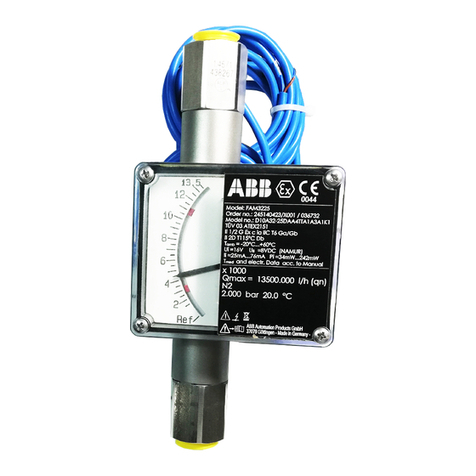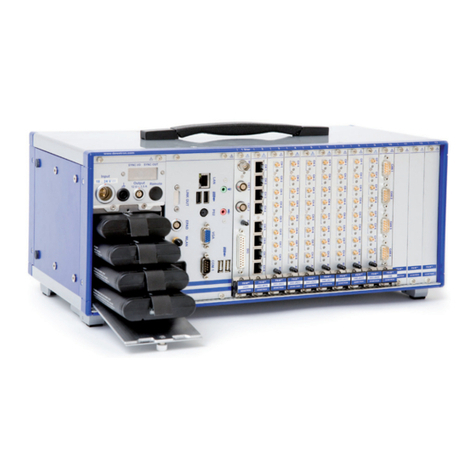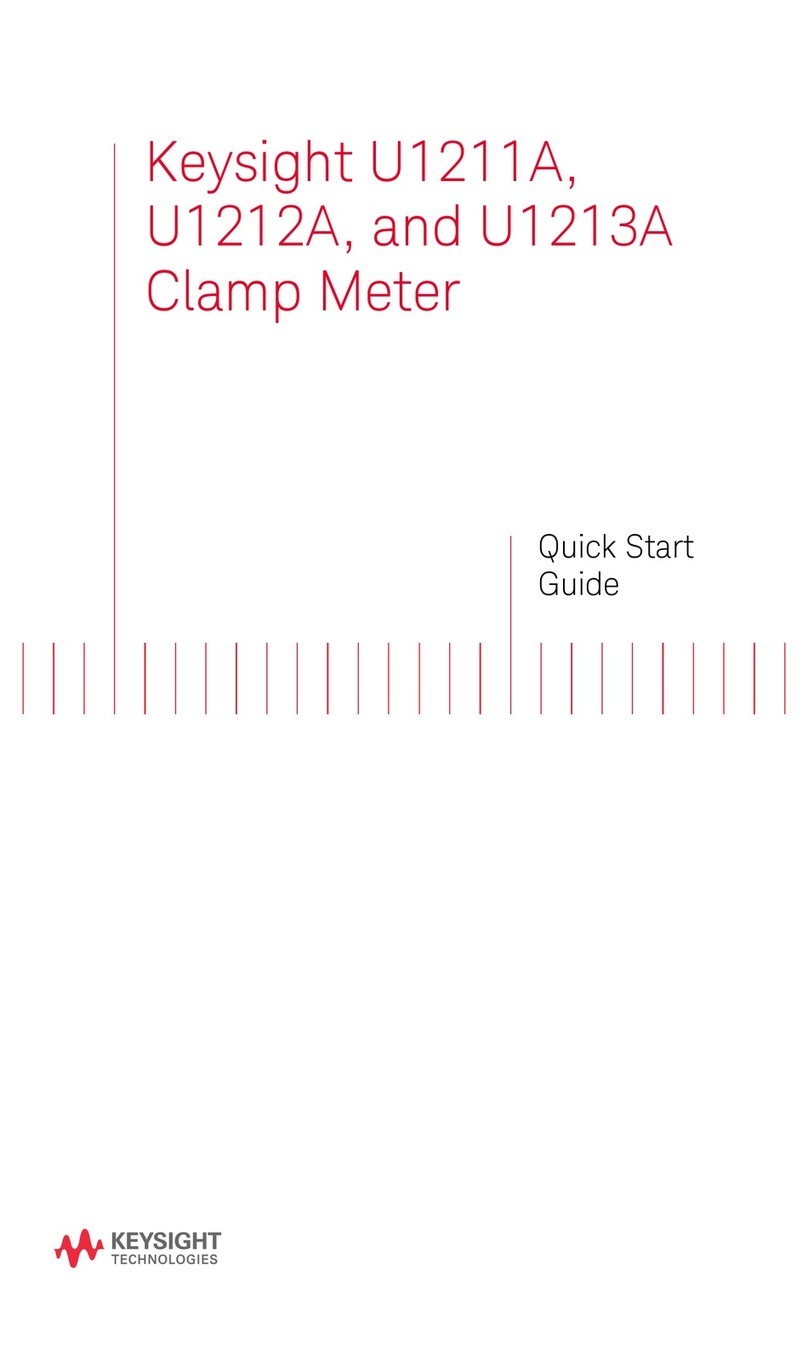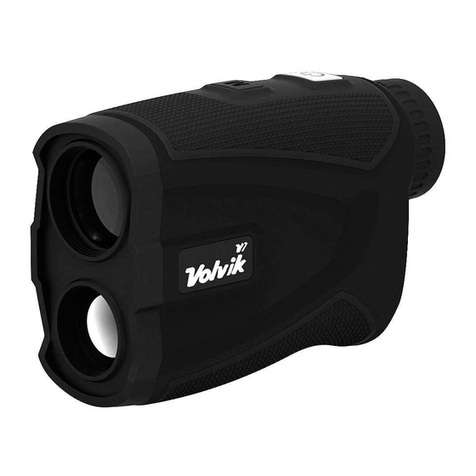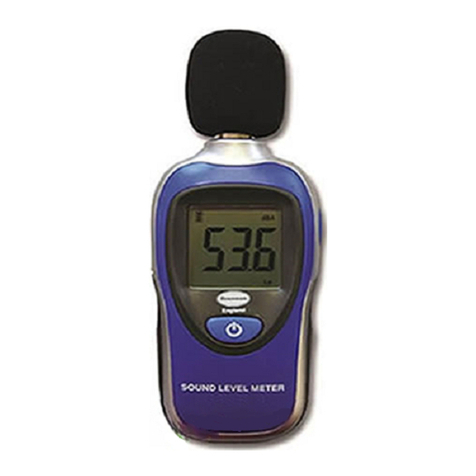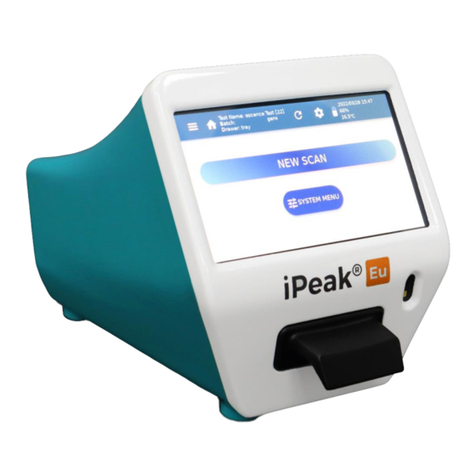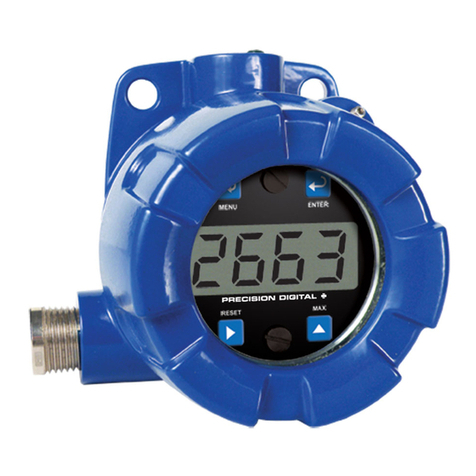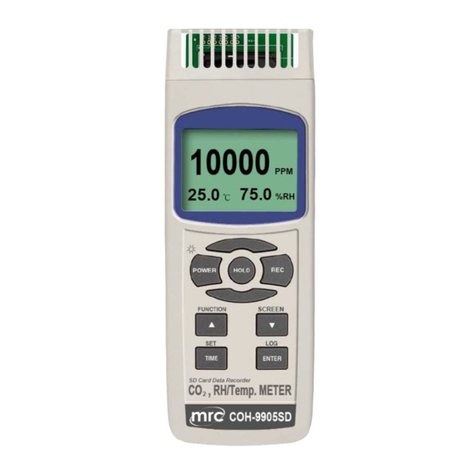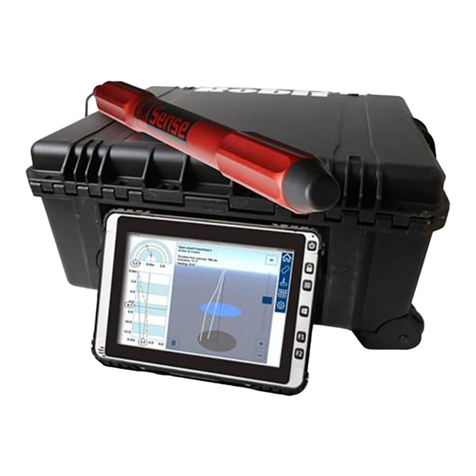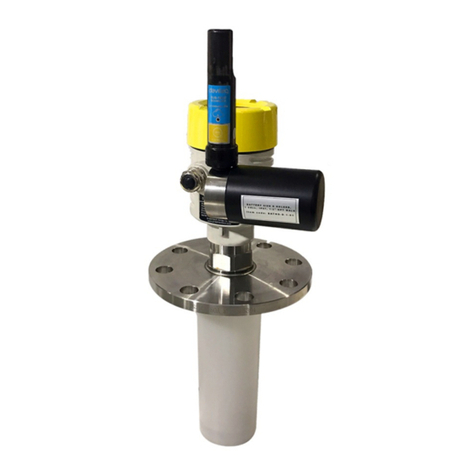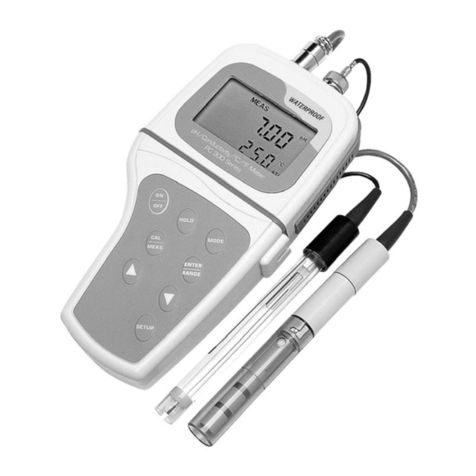STS Instruments Siloxane User manual

STS Instruments Ltd,
Installation Manual
201
8
SILOXANE MONITOR MANUAL
STS INSTRUMENTS LTD OPYRIGHT 2018
STS INSTRUMENTS LTD
|
www.siloxanemonitoring.com

1
16
th
August 2017, STS Instruments Ltd, Installation ManualInstallation Manual Jan 2018
TABLE OF ONTENTS
1.0
Manual Guide................................................................................................. 3
1.1 Document Version ............................................................................................ 3
1.2 Symbols Used .................................................................................................. 3
2.0 Safety Information ............................................................................................... 4
2.1 Environmental parameters .................................................................................. 4
2.2 Instrumentation Safety Symbols ............................................................................ 5
3.0 Overview .......................................................................................................... 6
3.1 Instrument Design ............................................................................................. 6
3.1.1 Instrument Schematic ................................................................................... 6
3.1.2 Instrument ................................................................................................ 6
3.2 Sampling System Design ..................................................................................... 8
3.2.1 Sampling System Schematics .......................................................................... 8
3.2.2 Sampling System ......................................................................................... 9
3.2.3 Sampling system gas testing .......................................................................... 10
3.3 Standard Instrument Features ............................................................................. 10
3.4 Optional Features ............................................................................................ 11
3.4.1 4-20mA data line ....................................................................................... 11
3.4.2 Remote Data access .................................................................................... 11
3.4.3 Solenoid Switching valves ............................................................................. 11
3.4.4 Kiosk enclosure fan control ........................................................................... 11
3.4.5 Heated line .............................................................................................. 11
3.5 Key omponents ............................................................................................. 11
3.5.1 Monitor & kiosk ......................................................................................... 11
3.5.2 Regulator ................................................................................................. 12
3.5.3 Automated Water Trap ................................................................................ 12
3.5.4 oalescing Filter ........................................................................................ 13
3.5.5 Line Switching Solenoids .............................................................................. 13
3.5.6 Heated Line .............................................................................................. 14
3.5.7 Purge Selection Solenoid .............................................................................. 14
3.5.8 Purge flow regulator ................................................................................... 15
3.6 SD ard ........................................................................................................ 15
3.7 Data connection line ........................................................................................ 16
3.8 Ancillary Box .................................................................................................. 16
3.9 Remote GSM Data console .................................................................................. 16
4.0 Installation ....................................................................................................... 17
4.1 Ventilation ................................................................................................. 17

2
16
th
August 2017, STS Instruments Ltd, Installation ManualInstallation Manual Jan 2018
4.2 Pre-installation ............................................................................................... 19
4.2.1 Nitrogen connection.................................................................................... 21
4.3 electrical setup .............................................................................................. 22
4.3.1 Power supply ............................................................................................ 22
4.3.2 omponents ............................................................................................. 22
4.3.3 ircuit .................................................................................................... 22
4.3.4 certification ............................................................................................. 23
4.3.5 Heated Line Specification ............................................................................. 24
4.3.6 Heated Line Installation and Termination Instructions .......................................... 25
4.4 Instrument onnections .................................................................................... 28
4.4.1 Biogas onnection ...................................................................................... 28
4.4.2 Nitrogen onnection ................................................................................... 28
4.4.3 Instrument Air Intake .................................................................................. 28
4.4.4 Instument air Exhaust .................................................................................. 28
4.4.5 Vent ....................................................................................................... 28
4.4.6 Power ..................................................................................................... 28
4.4.7 Data omms .............................................................................................. 29
4.4.8 Ancillary Box ............................................................................................. 29
4.4.9 Swagelok tube fittings ................................................................................. 30
5.0 Post Installation heck list .................................................................................... 31

3
16
th
August 2017, STS Instruments Ltd, Installation ManualInstallation Manual Jan 2018
1.0 MANUAL GUIDE
1.1 DO UMENT VERSION
Issued by
Author
Issue Date
Revision Number
STS
Jim Ward
1
9
/10
/2016
1.0
STS
Jim Ward
20/10/2016
1.1 Final
STS
Jim Ward
06/02/2017
1.2 Wording amends
P5,6,8
STS
Jim Ward
15/02/2017
1.3 wording amend P6
STS
Jim Ward
26/05/2017
1.4 Nitrogen onnection P19
STS
Jim Ward
16/08/2017
1.5 Amended kiosk diagram
, added additional flow
schematics 3.2.1.1/3.2.1.2 P8, added purge valve and
regulator P14, amended distribution board & description
P21
,
1.2 SYMBOLS USED
Safety
Warning
Identifies potential hazards
to either the user or the
installation.
Failure to follow this information may
result in physical injury that in some
cases could be fatal, cause irrevocable
damage to the instrument or damage to
the environment.
Electrical
Hazard
Identifies specific
electrical hazards to the
user.
Failure to follow this information may
result in physical injury that in some
cases could be fatal or may cause
irrevocable damage to the instrument.
Notes
Identifies areas where
clarification may be
required.
Should at any point you require additional help or information on the use or installation
of the system please contact STS at: sales@safetrainingsystems.com or +44 (0) 1344 483563

4
16
th
August 2017, STS Instruments Ltd, Installation ManualInstallation Manual Jan 2018
2.0 SAFETY INFORMATION
2.1 ENVIRONMENTAL PARAMETERS
The STS Siloxane Monitor operates from a 110V mains supply, the instrument case
should not therefore be opened without having first isolated the power supply and disconnected
the kettle lead form the rear of the instrument. The high voltage section of the instrument is
protected by clear cover – this should not be removed unless necessary- having followed the above
instructions. FAILURE TO ISOLATE THE SUPPLY MAY RESULT IN ELE TRI SHO K.
It is the responsibility of the owner of the instrument to complete a risk assessment on its
installation, operation and servicing before being commissioned for use.
Inhalation of gases may be harmful to health, it is the responsibility of the operator to ensure they
have adequate training in the safety aspects of handling biogas/landfill gas and that they follow
appropriate procedures at all times. The vent/exhaust form the instrument must be piped to an
area designated safe to discharge to atmosphere- a flame arrestor may be required to be fitted.
Installation and Maintenance of the unit should only be carried out by suitably trained personnel
according to the applicable code of practice.
Maintenance should be carried out only using STS approved replacement parts and components –
use of substitutes will invalidate the warranty and may be hazardous to both operator and
instrument.
No alterations should be made to the instrument or its ancillary components.
Failure to comply with the instructions in this manual could result in injury to the user.
The instrument captures fuel gas any work associated with the instrument must be carried out by a
class of person competent and certified to do so.
Should at any point you require additional help or information on the safe installation or
use of the system please contact STS at: sales@safetrainingsystems.com or +44 (0) 1344 483563

5
16
th
August 2017, STS Instruments Ltd, Installation ManualInstallation Manual Jan 2018
•The Siloxane Monitor is not weatherproof and must be housed in a suitable kiosk or cabinet
if sited outside of a building
•If siting inside a building consideration should be given to the local conditions as regards to
dust, moisture and ventilation the Monitor is available supplied in a 19” rack case suitable
for indoor use with inbuilt thermostatically controlled extraction fans.
•The monitor is suitable for use between 5 and 45 without additional cooling/heating
required.
•Gas supply to the instrument should be at a minimum of 200mbar
•Adequate ventilation/air passage around the instrument should be provided.
2.2 INSTRUMENTATION SAFETY SYMBOLS
aution
Electrical Hazard
Earth Point
Hot Surface

6
16
th
August 2017, STS Instruments Ltd, Installation ManualInstallation Manual Jan 2018
3.0 OVERVIEW
3.1 INSTRUMENT DESIGN
3.1.1 INSTRUMENT S HEMATI
3.1.2 INSTRUMENT
Biogas is supplied to the instrument via a sampling system that removes water and particulates.
The instrument has been assessed in accordance with IGE SR 25 for potential leakage risk and
development of explosive atmospheric conditions internal to the instrument.

7
16
th
August 2017, STS Instruments Ltd, Installation ManualInstallation Manual Jan 2018
The instrument is designed to be installed down stream of a boosted gas supply.
The design of the instrument is such that failure of any internal joint inside the instrument cannot
give rise to an explosive atmosphere inside the instrument. Nevertheless prior to energising the
instrument a tightness test including the instrument shall be performed. This test shall be in
accordance with IGE UP1B and include the instrument.
(35mb for 1 minute temperature stabilisation followed by a 2 minute tightness test). The tightness
test shall have no pressure drop.
The installer shall perform a let-by test of the upstream bio-gas section isolation valve. The valve
shall be closed and the pressure reduced to approx 50% of the operating pressure and tested for
let-by for a period of 1 minute. If a rise in pressure of more than the gauge readable movement
(GRM) is observed the isolation valve shall be replaced.
If during the tightness test there is a pressure drop then the instrument shall be disconnected and
the installation sealed with the appropriate fitting, the case shall be removed and the internal
elements inspected for damage. If the leakage cannot be corrected the instrument shall be
removed for factory inspection and correction.
Any work on the instrument shall be undertaken by a suitably competent person approved for the
time being by the Health and Safety Executive.

8
16
th
August 2017, STS Instruments Ltd, Installation ManualInstallation Manual Jan 2018
3.2 SAMPLING SYSTEM DESIGN
3.2.1 SAMPLING SYSTEM S HEMATI S
3.2.1.1 PRE-FILTER SAMPLE LINE FLOW S HEMATI

9
16
th
August 2017, STS Instruments Ltd, Installation ManualInstallation Manual Jan 2018
3.2.1.2 INTERMEDIATE AND POST FILTER SAMPLE LINE S HEMATI S
3.2.2 SAMPLING SYSTEM
Biogas is sampled by taking samples of raw and or treated biogas from the main gas pipework used
to supply the biogas engine.
The sampling arrangement may be single port or multiport, so that the instrument is capable of
sampling raw untreated gas, partially treated gas and treated gas prior to combustion in the biogas
engine.
The sample lines should be connected into purge points by means of a reducing T and additional
isolation valve. The sample points shall be installed so that the purge point on the main gas
pipeline remains usable for nitrogen or air purging.
The sample points shall be provided with individual isolation and test points to enable sample line
isolation and to enable sample line purging.
Sample pipelines shall be mounted on robust racking.
Sample lines shall be provided with trace heating and lagging from the instrument to the sample
point. Electrical power for the trace heating shall be taken from the instrument supply.
The sample line pressure shall be tested and a regulator selected to ensure an instrument sampling
system pressure does not exceed 35mb. If the system pressure has been declared by the operator
the installer shall nevertheless verify the site system pressure and selected regulator and ensure
that compliance with a 35mb inlet pressure is achieved.

10
16
th
August 2017, STS Instruments Ltd, Installation ManualInstallation Manual Jan 2018
The sampling pipework is directed to solenoid valves these are under the control of the instrument
which will select the sample it is measuring. The installer shall ensure that each sampling point is
directed to the correct solenoid in the sampling system.
Immediately after the solenoid valves the biogas is sent to a pressure regulator. Normally the
pressure regulator has been preselected for the site based on operator biogas pressure data. The
Installer is required to verify the pressure immediately downstream of the gas pressure regulator.
A coalescing (water trap) device is provided immediately after the regulator, the coalescing filter is
provided with an auto drain point. The auto drain is a potential methane release point and must be
terminated outside of any enclosed space, and marked with a warning label to indicate that it
could release methane.
After the coalescing filter some installations are provided with a flame arrester, this is an optional
feature selected by some operators. If a flame arrester has been provided the installer should
ensure that it does not excessively restrict gas flow during commissioning.
The final treatment stage in the sampling system is a particulate filter, this does not require
further checking during installation.
3.2.3 SAMPLING SYSTEM GAS TESTING
The siloxane instrument has an isolation valve immediately before the instrument, and immediately
after the solenoid valves.
The sampling system downstream of the gas regulator shall be tested in accordance with IGE UP1B.
(to 35mb with 1 minute temperature stabilisation followed by a 2 minute tightness test). There
shall be no discernible pressure drop over 2 minutes.
The sampling pipework shall be tested in accordance with IGE UP 1 Ed 2 except hydrostatic testing
shall not be used.
The testing shall be performed without trace heating being energised. For most installations the
stabilisation period will be 10 minutes with a strength test duration (STD) of 5 minutes, the
maximum % drop will be 20% of the Strength Test Pressure (STP)
For installations where the gas supply is less than 100mbar the stabilisation period will be 5 minutes
and the strength test duration (STD) will be 5 minutes.
With the trace heating energised the installer shall verify the temperature of the sample lines. The
minimum temperature for acceptable operation is 60 deg .
3.3 STANDARD INSTRUMENT FEATURES
•Membrane Keypad suitable for gloved use
•lear large L D display
•Internal datalogging with on screen recall
•Removable SD data card for data download
•Shock mounted feet to prevent vibration effects
•Temperature controlled operation

11
16
th
August 2017, STS Instruments Ltd, Installation ManualInstallation Manual Jan 2018
•Automatic system purging and safety cut outs
3.4 OPTIONAL FEATURES
3.4.1 4-20mA DATA LINE
Provided for the transfer of data to a 3
rd
party system.
3.4.2 REMOTE DATA A ESS
A data service accessible from any internet connection where individual or groups of monitors can
be viewed to see current and trend data on a secure website. Email alerts to set alarm thresholds
may be configured and data downloaded as SV files.
3.4.3 SOLENOID SWIT HING VALVES
Provided to allow a number of different sampling points to be monitored automatically.
3.4.4 KIOSK EN LOSURE FAN ONTROL
For temperature control to prevent overheating of the instrument in hot environments.
3.4.5 HEATED LINE
Used where pipework is run outside of buildings to prevent diurnal fluctuation due to condensation
of Siloxanes into pipework – typically 16A.
3.5 KEY OMPONENTS
3.5.1 MONITOR & KIOSK

12
16
th
August 2017, STS Instruments Ltd, Installation ManualInstallation Manual Jan 2018
3.5.2 REGULATOR
The sampling system uses a Gas regulator set to a maximum outlet pressure of 35mbar, the
regulators are unidirectional so care must be taken to ensure correct orientation to the flow.
Testing must not place a back pressure on the regulator greater than 35mbar or damage to the unit
may result.
3.5.3 AUTOMATED WATER TRAP
The automated water trap is designed to remove excess moisture form the gas stream before
entering the instrument. The trap should be located such that it is vertically mounted by means of
the fixing bracket at the top of the unit. The trap is powered and activated by the Siloxane
Monitor via the Ancillary box which supplies the trap with 24V to operate the solenoid switch.

13
16
th
August 2017, STS Instruments Ltd, Installation ManualInstallation Manual Jan 2018
3.5.4 OALES ING FILTER
The coalescing trap is designed to remove very fine water particles from the gas stream, it should
be situated in line between the water trap and the flame arrestor. The trap should be secured
vertically by means of the fitting at the top of the unit This trap does not drain and should not have
any visible water inside. If there is water present, the filter element should be changed
immediately and the auto drain trap should also be checked to ensure its correct function.
Note: The fittings on the oalescer are 1/8
”
NPT to ¼” Swagelok
3.5.5 LINE SWIT HING SOLENOIDS
Where more than 1 sample line is being installed the kiosk is configured with up to 3 electrical
operated switching solenoid valves. These valves are orientated such that the normally closed
The automated trap will activate when the internal float rises sufficiently to trigger the
solenoid valve to be opened. The fluid is evacuated from the reservoir by the incoming gas
pressure until the float returns to the rest position which closes the solenoid.
The oalescing filter should be changed annually – once replaced ensure that the vessel
is pressure tested for leaks before setting the system live.

14
16
th
August 2017, STS Instruments Ltd, Installation ManualInstallation Manual Jan 2018
orifice faces the incoming flow. This means that the valve is always closed unless powered open
when that line is selected for sampling. This reduces any leakage potential from the valves.
Where switching valves are used they must be fitted after the Regulator and an Isolation valve
fitted for each line.
3.5.6 HEATED LINE
The heated line is connected to the distribution panel via the thermostat box. The line requires a
16A supply. The Heated line and temperature sensor are passed through the gland plate of the
kiosk and the incoming biogas sample line are bundled with the heated line and sensor are
insulated using pertec waterproof insulation.
3.5.7 PURGE SELE TION SOLENOID
The instrument operates a purging system between each sample that ensures that the line is not
contaminated by the previous sample. The purge selection solenoid switches the line from going
through the instrument to being sent to the vent pipe. This should be connected with the gas
entering the NO port, the purge being connected to the N and the instrument to the ommon.
The line temperature is set at 60 to prevent condensing of the siloxanes in the
pipework.

15
16
th
August 2017, STS Instruments Ltd, Installation ManualInstallation Manual Jan 2018
3.5.8 PURGE FLOW REGULATOR
In order to regulate the amount of gas exhausted during purging an inline regulator is used. The
regulator is factory set at 200-250ml/min.
3.6 SD ARD
A standard SD card of 2GB or greater is required. The Instrument will not correctly run without this
SD card and will RASH upon starting a Logging ycle.

16
16
th
August 2017, STS Instruments Ltd, Installation ManualInstallation Manual Jan 2018
3.7 DATA ONNE TION LINE
On the rear of the instrument there is a 12-way connector (colour coded Blue) which is for
connection of the 4-20mV data lines. The instrument supports up to 4 data parameters. Where
specified this connector is mated to the Remote GSM Data onsole.
3.8 AN ILLARY BOX
Sample line switching to solenoids 1-3
24V supply to Water trap
24V Exterior cabinet fan supply
3.9 REMOTE GSM DATA ONSOLE
Where specified a GSM data communications box is fitted which takes the 4-20mV inputs from the
instrument via the 12-way (Blue) connector. This box houses an internal area and is preconfigured
for each site. Should alteration to the unit be required please contact STS for further information.
Danger of electrocution – disconnect from mains supply before opening box.

17
16
th
August 2017, STS Instruments Ltd, Installation ManualInstallation Manual Jan 2018
4.0 INSTALLATION
The siloxane instrument is designed for installation in a building or kiosk, the instrument and
sampling system are available pre-mounted in a weather proof kiosk, the container is provided with
all necessary vent, drain and power connections.
If the instrument is being installed in a building or kiosk that contains other equipment, then it
should be provided with:
Approved instrument vent connections
Electrical Power
Nitrogen Purge connection
Biogas sampling connections
Drain connection
Sample Vent connection.
4.1 VENTILATION
The instrument ventilation is designed to prevent any risk of a build-up of methane inside the
instrument, the correct provision of the vents is necessary to ensure that the instrument remains
safe.
The ventilation shall be configured so that the air supply to the instrument is drawn through a grill
from a horizontal duct laid with a 3 degree fall away from the instrument.
The discharge vent connection shall be discharged outside of the building at a safe location, the
discharge vent shall be terminated with a bend to prevent wind driven rain from entering the duct.
(where the standard STS kiosk is supplied all vents are covered with cowls to prevent ingress)

18
16
th
August 2017, STS Instruments Ltd, Installation ManualInstallation Manual Jan 2018
The Kiosk is ventilated through an open grille to the lower right hand side providing through air
ventilation, A thermostatically controlled fan assists in additional ventilation – this is set to operate
at temperatures over 10 .

19
16
th
August 2017, STS Instruments Ltd, Installation ManualInstallation Manual Jan 2018
4.2 PRE-INSTALLATION
Kiosk siting and fixing down:
Other manuals for Siloxane
4
Table of contents
Other STS Instruments Measuring Instrument manuals
Popular Measuring Instrument manuals by other brands
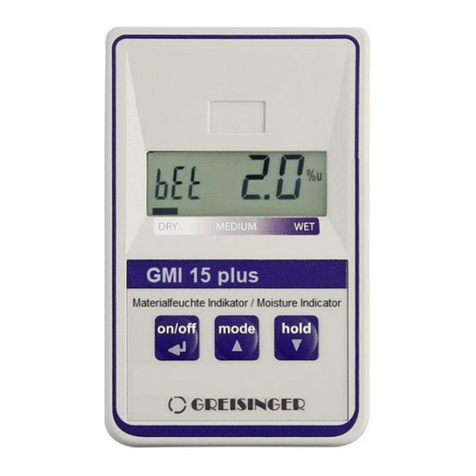
GHM
GHM GREISINGER GMI 15 plus operating manual

Chino
Chino AH4000 Instructional guide

McCrometer
McCrometer Water Specialties ML04D Operation and maintenance manual and part list
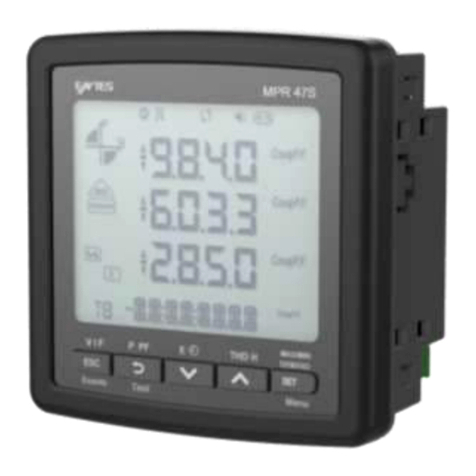
Entes
Entes MPR-4 Series user manual
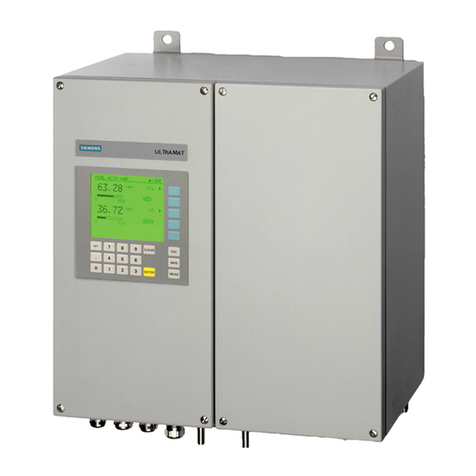
Siemens
Siemens CALOMAT 6 Additional Equipment Manual

horiba
horiba ihr550 Quick installation and operation guide
